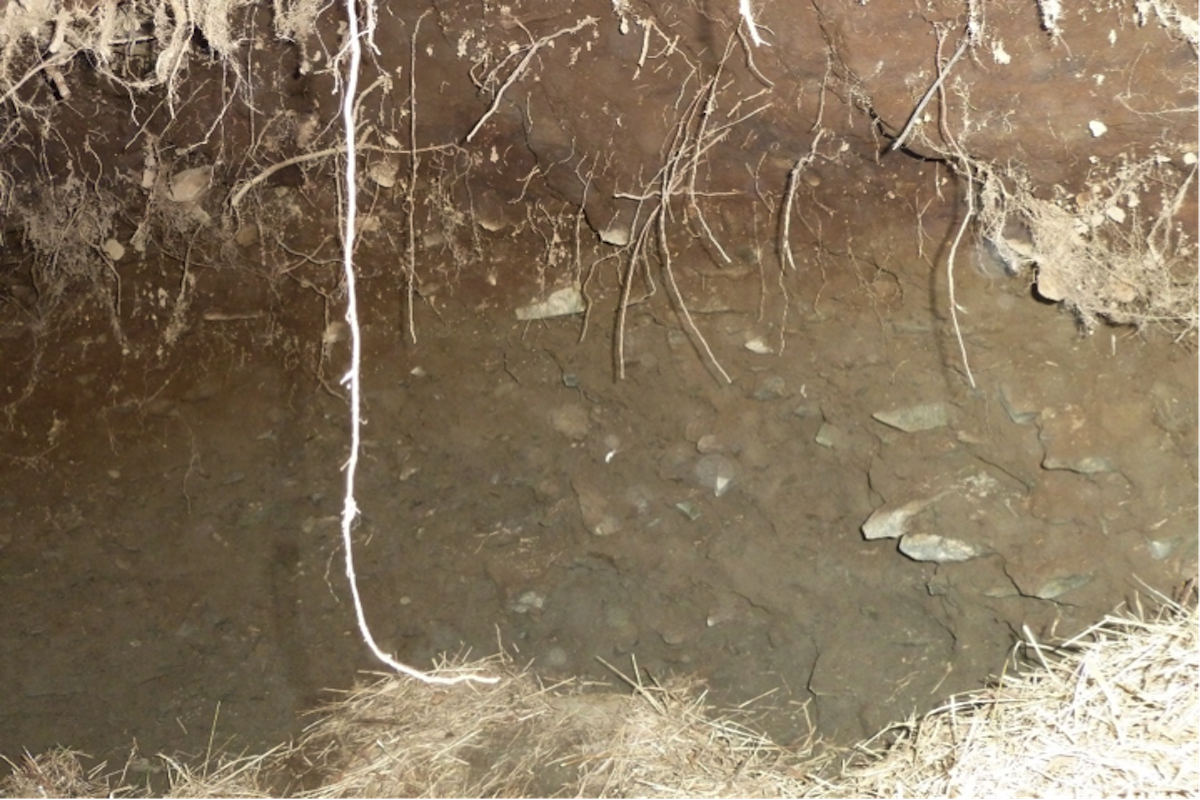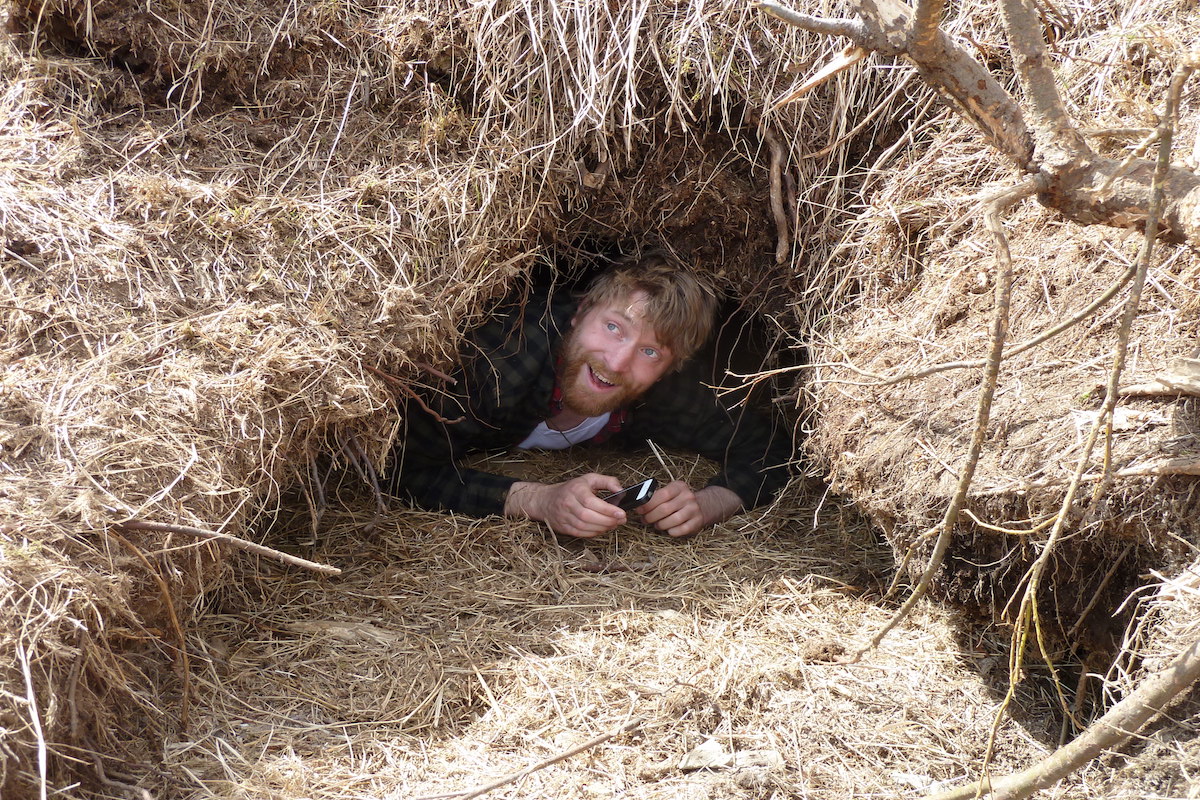Generally speaking, it is not advisable to crawl into a recently evacuated bear den while a mother bear with two cubs grazes within one hundred yards. But generally speaking, rangers are a curious lot, and so each of us leapt (or scrambled) at the opportunity to dive into the Earth.
A few words of scene setting may be in order. The day is Sunday, May 21. The weather is shockingly warm for the season, (approaching the 60s in finer moments) and the sun peaks invitingly through blankets of clouds. Rangers returning and new have set out to reach the summit of Dumpling Mountain, the seemingly-gentle sloping mound that rises to the North of Brooks Camp. We have thus far scaled some two thousand feet above camp, and the view is arrestingly beautiful. Sprawling beneath us are the turquoise waters of Naknek Lake and the deep blue of Brooks Lake, with dozens of snow-drenched peaks jutting thousands of feet above the forest rising on the horizon. At our feet are dozens of different tundra plants: from delicate purple lousewort to tangled, skeletal reindeer lichen, a wonder-world of dense mats of curious life. If one does not mind staining clothes with crowberry, it is the perfect spot to rest and reflect.
Rangers, however, cannot go long without poking around, and soon we are diving down into deep valleys and up slopes tangled with willow and alder to check out a patchwork of dark spots on nearby hillsides. This particular gaggle of wanderers has a bear biologist among our company, and he has spotted the telltale signs of bear dens. The scratches of stiff stems and the jelly-legs born of steep ascents are soon rewarded. A single hillside holds over a dozen dens, all only recently abandoned. They do not look like much from a distance, only the tiniest pinpricks of darkness on brown-green hillsides, but these holes tell another story up close. Deep claw marks score the land around them, the darkness beyond a curtain of roots seems ominous with possibility.
Photo courtesy L. Law: the author provides a sense of scale at the entrance to a den. The bear that occupied this space would have easily been twice his size.
I find myself doing something I would never consider under ordinary circumstances. Inching forward on hands and knees, I wriggle into the former home of a 600+ pound predator. The interior is surprisingly snug. I cannot even sit up inside of the den. The soil walls are uncomfortably close on all sides, and a curtain of roots brushes against my head.
It is difficult to imagine the immense frame of a bear, rotund from hundreds of salmon, fitting comfortably in this confined space for a few moments, much less an entire winter. But this was home for a massive animal for half of a year. It is an intimate look into the life of a bear. In this small hole, a bear barely stirred through the blanket of winter, neither consuming food nor producing waste. Its body was strikingly resilient, losing next to no bone or muscle in conditions that would destroy a human frame. It may have been a mother nursing cubs, each one just one pound when born in the depths of winter, her paws draped protectively over them as she existed under the spell of an intense lethargy. These cubs weigh only about four to ten pounds when they exit the den in spring.

Photo Courtesy of C. Augustson: It is difficult to get a good photo of the interior of a den. This represents the author’s best attempt.
In this instance, we did not need to imagine a mother bear and cubs, because we had live models nearby! As we poked around the earthy abodes, a mother bear and her two young lay in the grass just over the hill. We watched her behavior carefully for signs of distress. She watched us briefly before returning to her rest, but we were vigilant as long as we were in her range, exercising great care to ensure we were not disturbing her rest. Spring is a vulnerable time for these bears, as food is not yet plentiful and they are careworn from the long months of hibernation. Forcing a bear to run or defend its young in this time would waste precious energy resources for a lethargic bear, making her situation and that of her cubs more precarious. We are ever reminded that we are guests in their homeland, and our actions are carried out with this constant awareness.
As we plan our next steps on a slope further away, we see another bear, this one on its own, approaching perhaps a bit too close to our resting stop, paying us no heed as it ambles along. As we plow up the mountainside to put space between us and the bears below, many thoughts pass through my mind. I consider the immense privilege of being able to work in such a wild, and complex land. I consider how much land, how many resources, are needed to make a home for a single bear. I marvel at sharing space with such powerful creatures, and feel strangely humbled at getting such an intimate view of their lives.
Photo courtesy of M. Bradburn: A mother bear and her three cubs examine their surroundings near Brooks Camp in July.
I also turn my thoughts to the heaviness of my own lungs and the wobbliness of my legs as we reach the spectacular summit. This is a wild world, and we share this land with some of the hardiest creatures on the planet.


